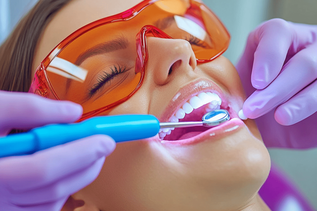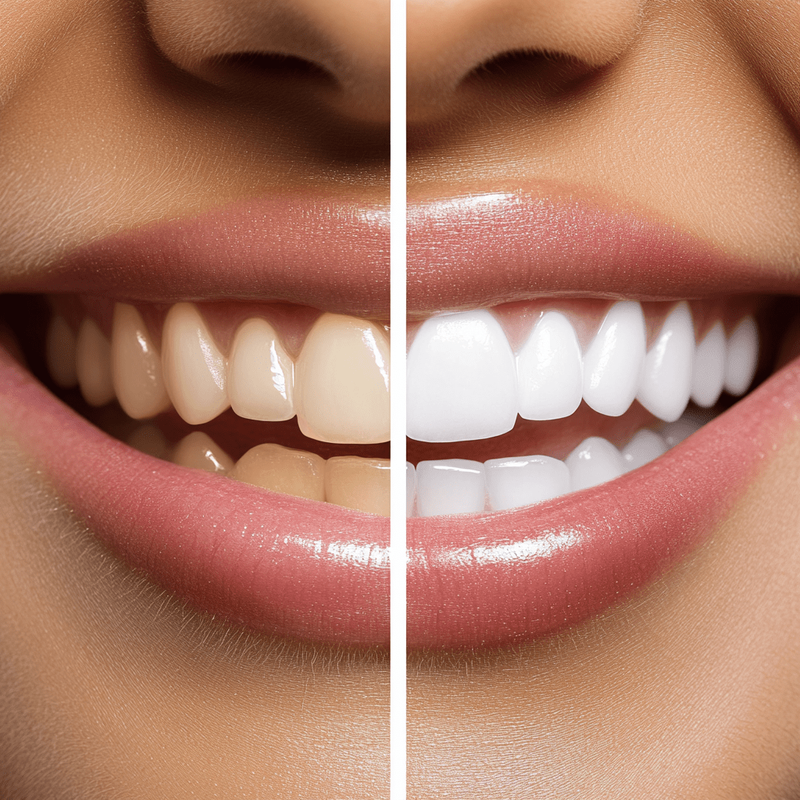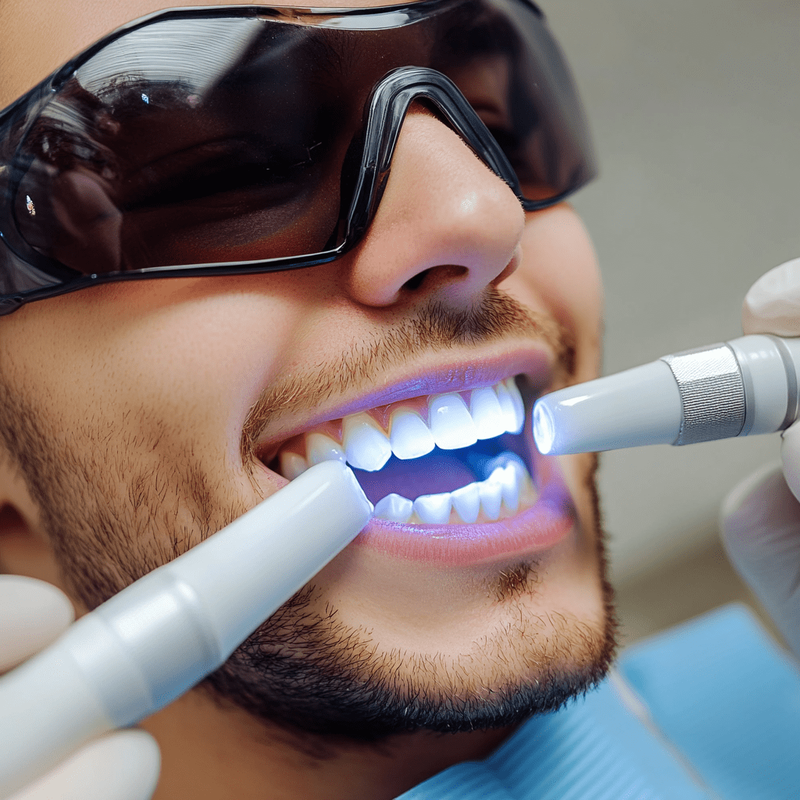
Teeth Whiteners: Are They Safe and Effective?
Sometimes, even with the best care, our teeth can start to look pale yellow, while all we want is to flash a pearly and white pristine smile. It’s common for teeth to lose their milky white appearance as we age and get a pale tint from the variety of food and drinks we enjoy. And brushing and flossing regularly can only go so far. To keep teeth white and benefit from the added confidence they come with, many people are thus now turning to teeth whitening products.
If you are also someone exploring teeth whitening products and thinking about how does teeth whitening work, is teeth whitening safe, what are the different products, this page will guide you through it all.
Types of Teeth Whiteners
Teeth whitening products have gained popularity and now tooth whiteners come in different forms such as:
- Whitening Strips
Whitening strips are thin and flexible plastic strips that people apply on their teeth directly. These strips are coated with a peroxide-containing whitening gel. People have to apply them for a specific time duration. Wondering how do whitening strips work? In the time the user is wearing it, the bleaching agent in the strips breaks down the stains in teeth giving a whiter and cleaner appearance after routine applications and use.
- Whitening Gels
Whitening gels are typically used with trays. They contain more concentration of bleaching chemicals like hydrogen peroxide or carbamide peroxide. These chemicals seep into the enamel of users to lighten the stains from within.
However, people may not get as good results with these every time because the gels get washed out in the mouth or become diluted in the oral cavity.
- Whitening Toothpaste
Whitening toothpaste is more of a regular product and is considered the best teeth whitening product by many. These contain mildly abrasive ingredients and bleaching or chemical agents like hydrated silica, sodium bicarbonate, etc. which can remove the upper layer or surface stains from the teeth of users.
If you are wondering does whitening toothpaste work, it surely does, however, it has limited whitening results compared to other products because of the mild and safer proportions of ingredients.
- Whitening Trays
These are custom-fitted trays filled with whitening gel that people wear over a specific time duration. It enables a more even application of the gel on teeth and more effective whitening action and results because the application doesn’t get affected. These trays work similarly to how whitening gels work, containing agents that address teeth stains and paleness to bring out whiter teeth.
How Do Teeth Whiteners Work?
Different tooth whiteners available in the market typically rely on active ingredients like hydro peroxide or carbamide peroxide to break down spots and stains on teeth and discoloration that causes an unappealing appearance. Here’s how these products work:
Active Ingredients
The active ingredients hydrogen peroxide and carbamide peroxide are typically the most used chemicals in teeth whitening products. While the former is active alone the latter breaks down into hydrogen peroxide and urea upon action. These peroxide chemicals can easily penetrate the porous enamel or outer layer of the teeth and make their way into the dentin layer underneath.
Oxidation
The active oxygen molecules present in these whitening agents then react with the discolored chemicals or compounds present in the teeth via a process named oxidation.
Molecular Breakdown
The oxidation reaction breaks down those discolored molecules and spreads them far apart. This results in the whitening of the teeth while the enamel stays intact.
Penetration
The peroxide containing chemicals can work on and break down these discolored molecules present on the teeth surface as well as those present in the inner layer too by penetrating inside.
Overall Process
It depends on the concentration of whitening agent present in teeth whitening products and how far the whitening process goes into the teeth. Higher concentrations can trigger the oxidation reaction deep in the tooth enamel while lower concentrations can address surface stains and discoloration by altering the chromogens or color compounds in the teeth to give a whiter appearance to the users.

Are Teeth Whiteners Safe?
If you are wondering are whitening strips bad for your teeth or if they are safe to use or thinking just the same about any other teeth whitening product, here’s the answer: Teeth whitening products are generally safe and many people are using them with not many having severe reactions. However, they do cause side effects like they can make your teeth more sensitive and cause gum irritation.
So it's always advised to use in proper dosage and only use for a specific time period and not make any of the products that are not advised to be used regularly part of your regular dental routine. For example, some strips with higher concentrations of these chemicals should not be applied daily, whereas the teeth whitening products with milder ingredients and lower concentrations like toothpaste are something that you can use on a daily basis.
Some research and studies show that the active bleaching agents present in these teeth-whitening products can actually damage the tooth structure at the macro level too when misused. So to avoid all of these risks, patients or people seeking whiter teeth should always consult a dentist and follow the usage instructions very carefully and precisely.
Effectiveness of Teeth Whiteners
The effectiveness of teeth whiteners depends on factors like the type of stain that your teeth might have, the duration of use, and the concentration of active ingredients in the tooth and teeth whitening products. Typically, whiteners are generally more effective at removing the stains present on the outermost layer of the teeth, and results may be visible after regular use over several weeks.
However, suppose you compare these at-home whitening products with professional teething whitening done by dentists, the results of the latter are far better and quicker because the dentist can judge your overall dental health and choose the best concentration of active ingredients for you and give you results in a more controlled and effective manner.
Pros and Cons of Using Teeth Whiteners
Here are some pros and cons of using teeth whiteners:
Pros
Affordability
At-home teeth whitening options are less expensive than professional teeth whitening treatments offered at dental clinics.
Convenience
Many over-the-counter teeth whitening products can be used by people at home without visiting dentists unless they have sensitivity issues.
Cons
Slower Results
At-home teeth whitening treatments and products usually take longer to show noticeable results when used in advised timing and frequency.
Uneven Whitening
Paleness and whitening together can cause patchy outcomes as a result of improper application or improper use of these teeth whitening products at home.

Who Should Use Teeth Whiteners?
If you're wondering who should use teeth whiteners, the ideal users are generally people with extrinsic stains from the beverages they've drank or food they've eaten or over time stains and paleness caused by smoking and have good overall dental health. However, those people who have paleness and want teeth whitening but are dealing with existing dental issues, have increased teeth sensitivity, they are either pregnant or breastfeeding, should consult a dentist before using any of the at-home teeth whitening products.
Professional Teeth Whitening at Mapleridge Dentistry
Now that you know how to get white teeth, if you are torn between options and worried about the safety of teeth whitening treatments given the associated risks, it’s time for you to consult a dentist for quick and effective results. Going to Mapleridge Dentistry can be your best choice for getting whiter teeth. At Mapleridge Dentistry, our team offers teeth whitening services that can give you immediate and noticeable results by using appropriate concentrations of whitening agents and tailoring our approach to every patient's needs, resulting in a brighter smile in just one visit.
Our dental team ensures the safety and effectiveness of the teeth whitening treatment on the whole and can take care of all your dental needs seamlessly.
Ring them today and get brighter and shinier teeth easily!

